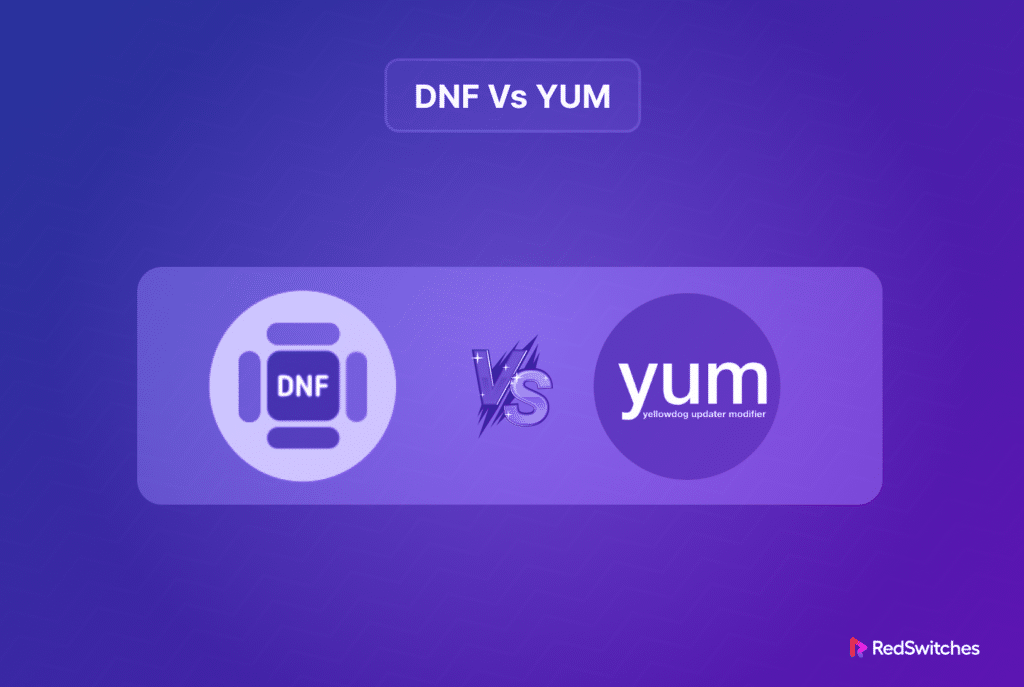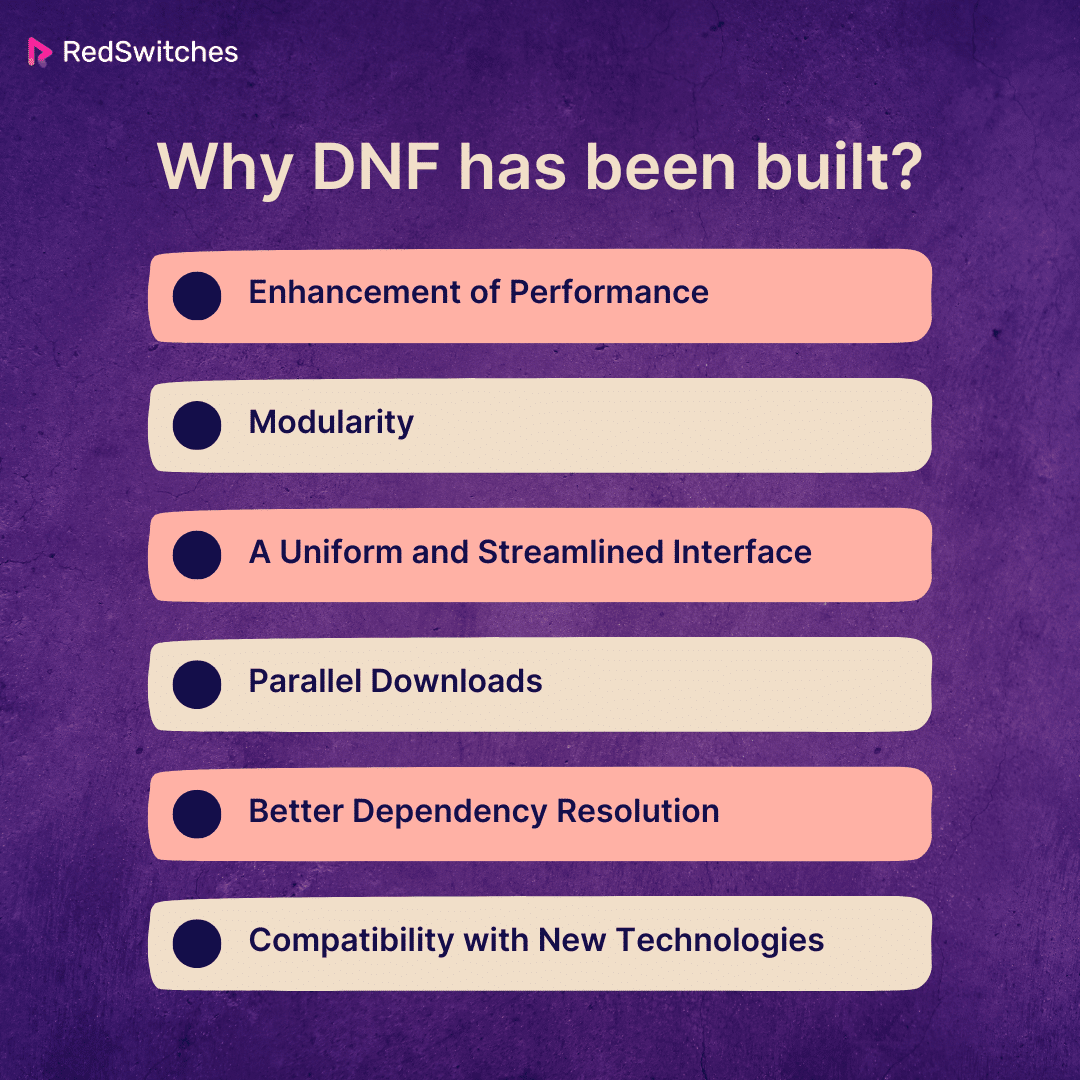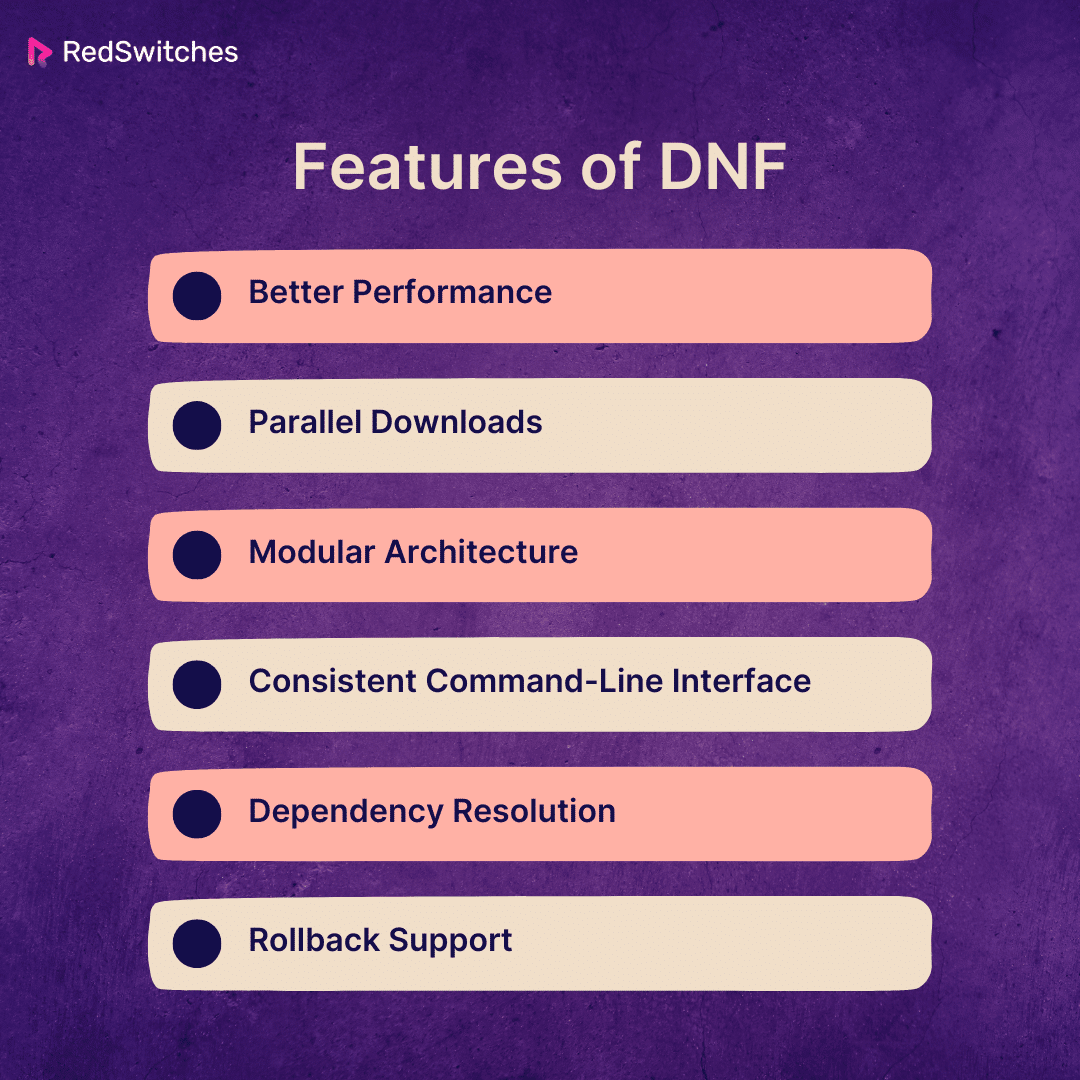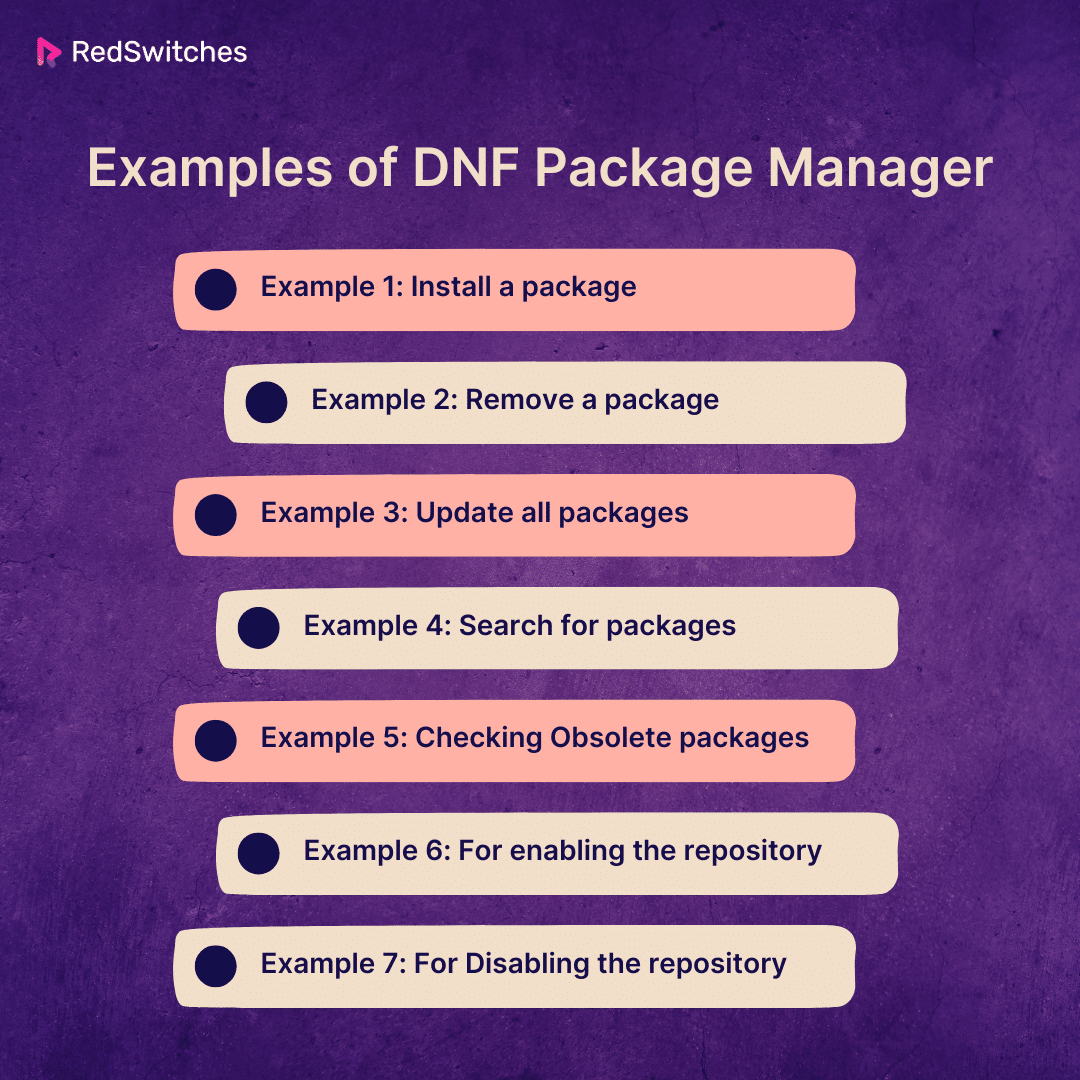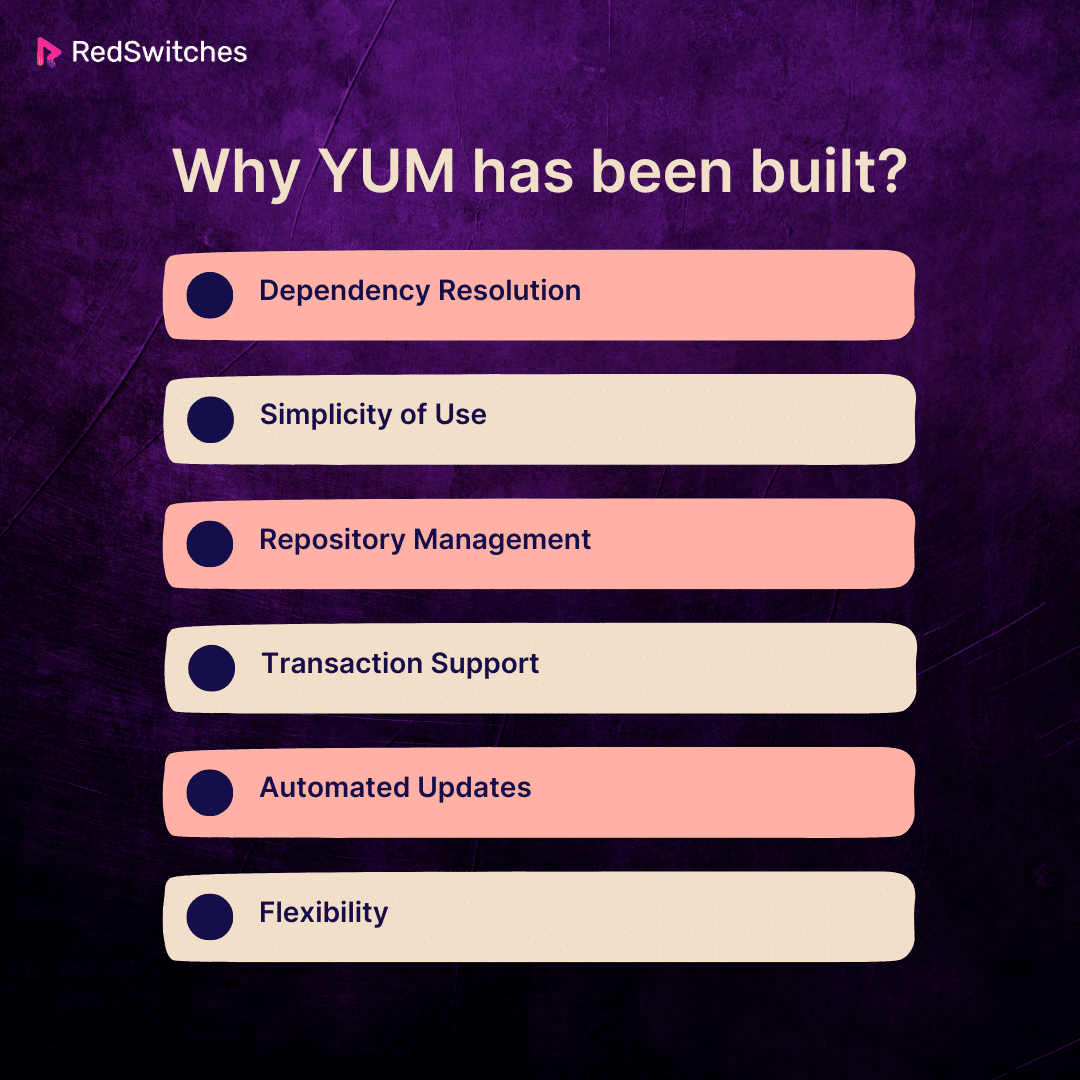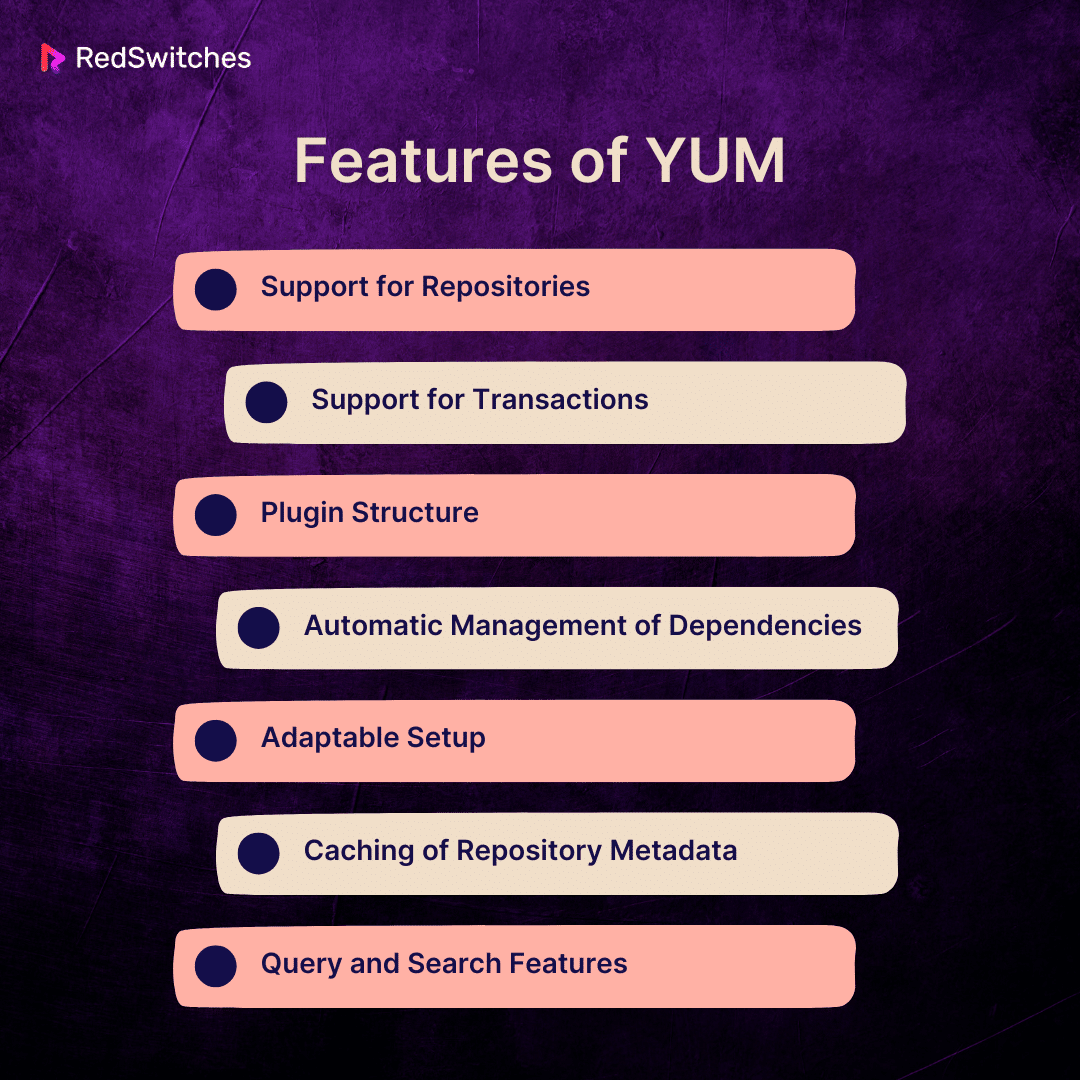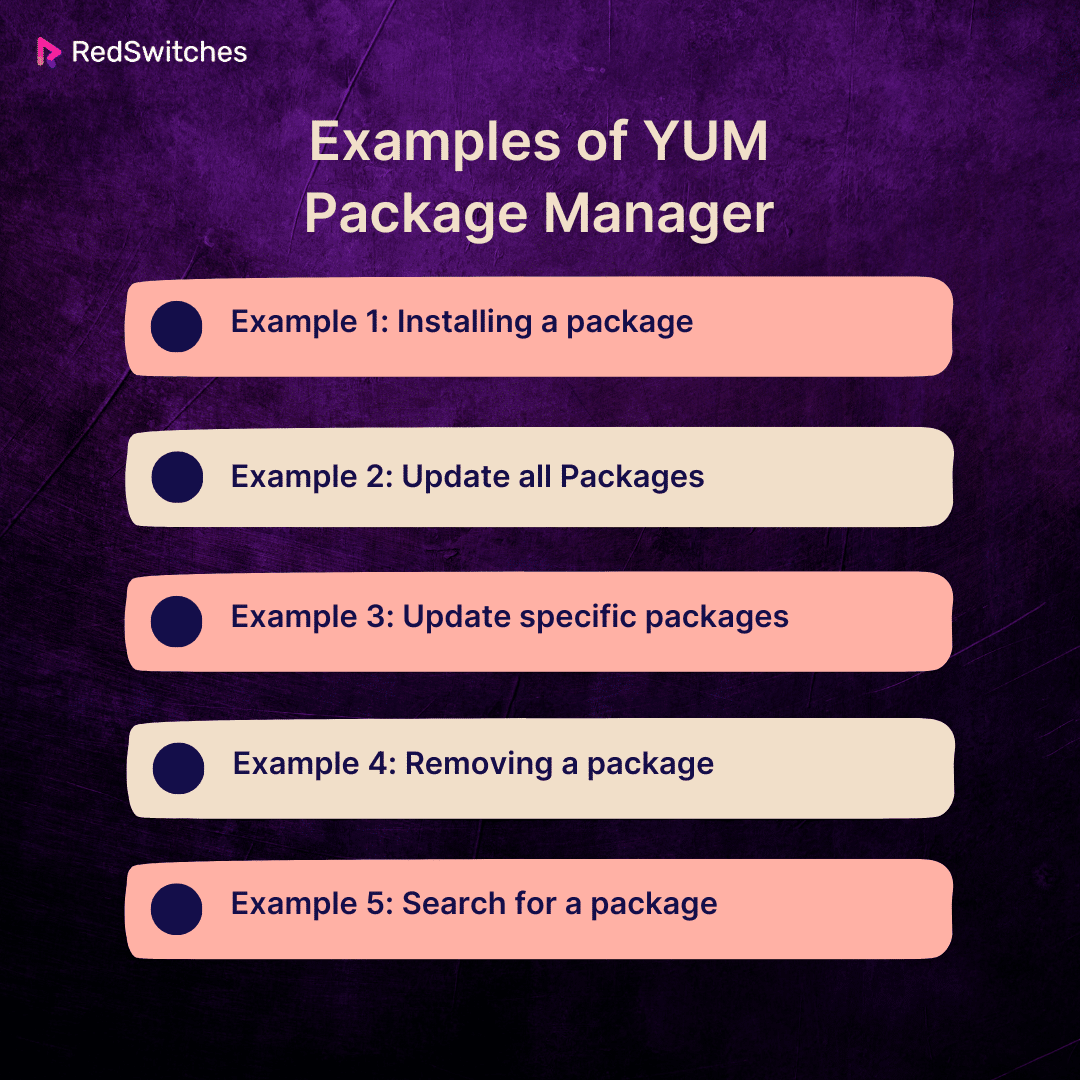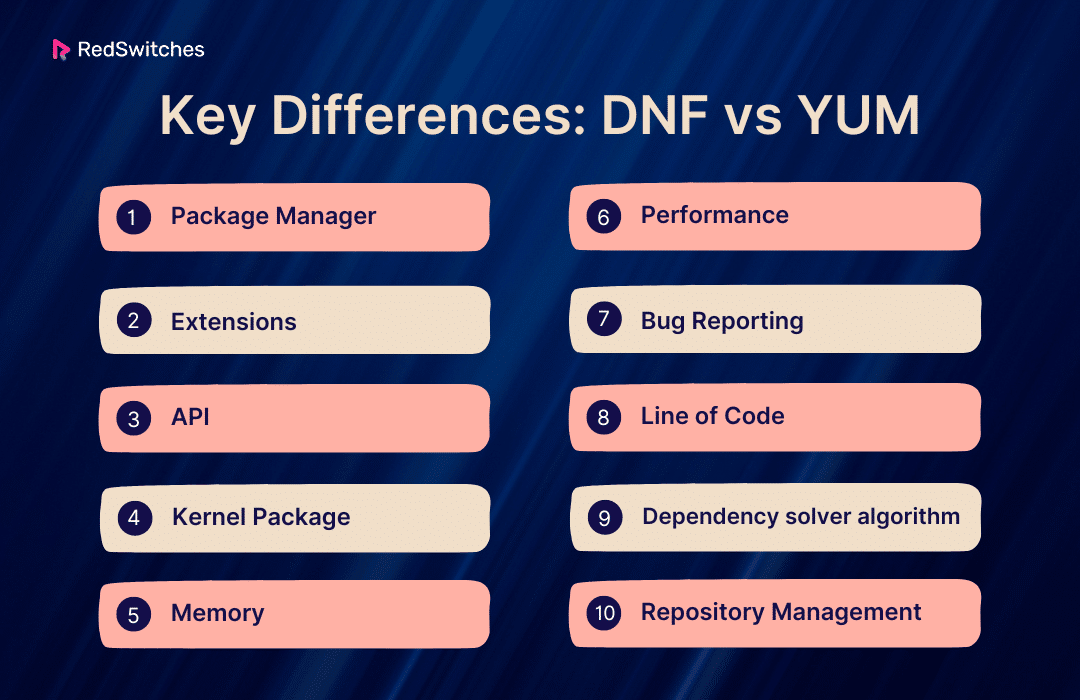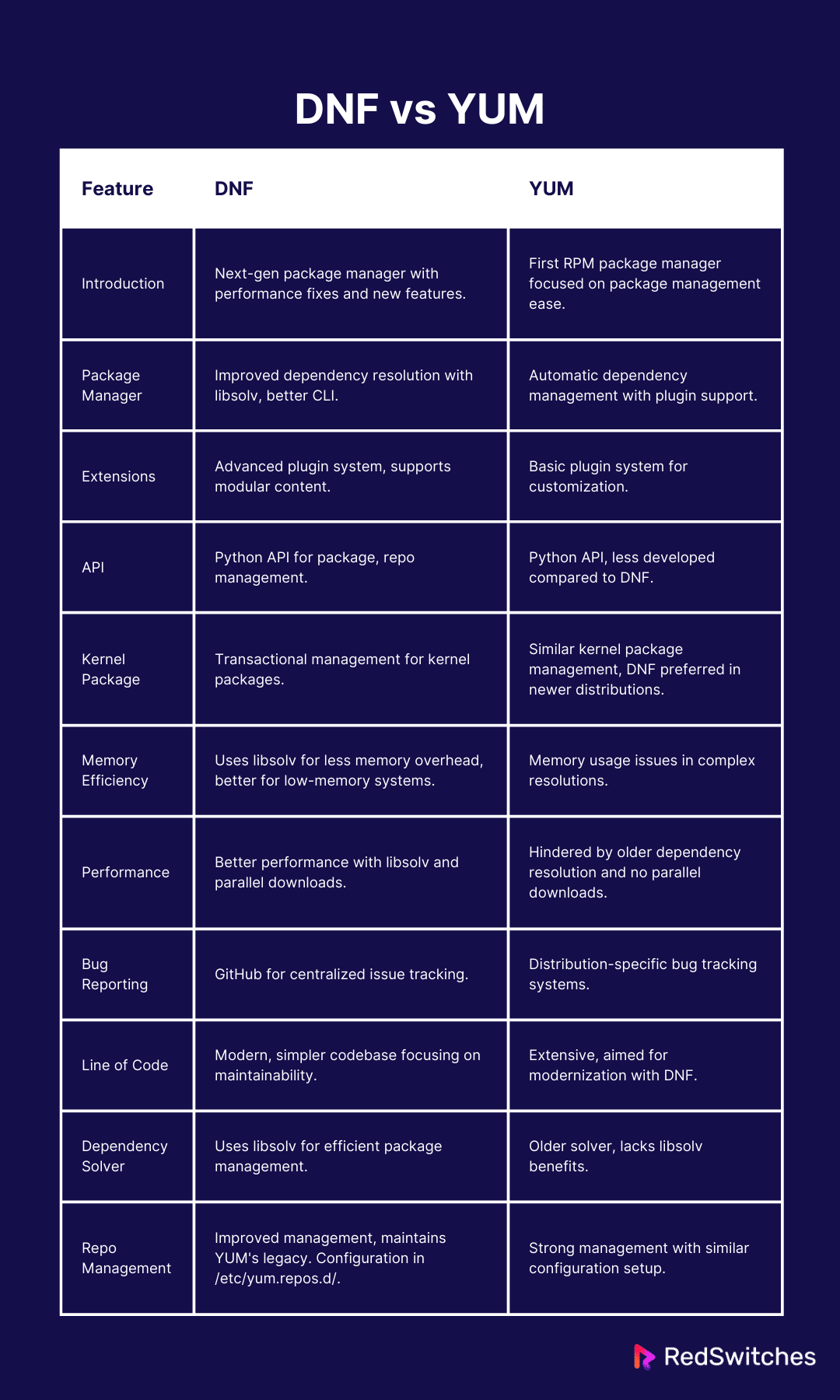Key Takeaways
- DNF (Dandified YUM) is the next-generation package manager for RPM-based Linux distributions.
- YUM (Yellowdog Updater, Modified) played a foundational role in RPM-based package management, focusing on ease of use.
- DNF outshines YUM in terms of performance and memory efficiency thanks to its use of libsolv for dependency resolution and support for parallel downloads.
- DNF’s architecture is more modular and flexible, allowing for easier maintenance and adaptation to changing needs.
- Both YUM and DNF offer streamlined command-line interfaces, but DNF is designed to be more consistent and user-friendly.
- DNF is built to be compatible with new technologies in the Linux ecosystem, making it more suited for modern RPM-based Linux distributions.
- The choice largely depends on the specific needs and environment.
- DNF is generally recommended for modern distributions due to its performance and features, while YUM might still be in use for older systems or by users familiar with its operations.
Step into the Linux package management ring, where DNF and YUM are two strong competitors vying for dominion online. This confrontation piques interest and feeds the never-ending discussions among tech enthusiasts. Consider this conflict a symphony of code, with each note signifying a crucial difference between these reliable package managers.
In this piece, we aim to clarify the complexities of the DNF vs. YUM argument by breaking down the binary battlefield and highlighting ten crucial distinctions. Fasten your seatbelts and join us as we explore updates, dependencies, and repositories to understand the subtleties that drive the Linux ecosystem.
Together, we will explore this fascinating area where functionality and choice collide and where lines of code represent the future of package management.
Table of Contents
- Key Takeaways
- What is DNF?
- What is YUM?
- Key Differences: DNF vs YUM
- Which One to Choose: DNF or YUM?
- Conclusion
- FAQs
What is DNF?
A package manager called DNF, or Dandified Yum, is used in many Linux distributions, especially those based on Red Hat, like Fedora and CentOS. DNF was released with improved package management features to get around some of the issues with YUM (Yellowdog Updater, Modified).
While keeping YUM’s essential features, DNF adds the Hawkey library for better performance and dependency resolution. It has a more modular architecture, a more straightforward and uniform command-line interface, and enables performance-enhancing features like parallel downloading.
DNF’s main objective is to simplify software package management, installation, and removal of Linux systems. When interacting with software repositories, it retrieves and installs packages and their dependencies. DNF is critical in preserving system integrity by managing updates, guaranteeing compatibility, and effectively resolving dependencies.
Why DNF has been built?
So why DNF was developed? There are several reasons why DNF was built. Let’s understand.
Enhancement of Performance
DNF was created to solve YUM’s performance issues. It uses the Hawkey library, which improves general efficiency and dependency resolution. Package management procedures in DNF are faster and more effective when contemporary technologies are used.
Modularity
Compared to YUM, DNF’s architecture is more modular. Its modular design makes it easier to maintain and more flexible, so it can adapt to changing user needs and shifts in the Linux environment.
A Uniform and Streamlined Interface
DNF hopes to improve its usability and intuitiveness by offering a standardized and streamlined command-line interface. Users, including system administrators and software developers, can now engage with package management more easily.
Parallel Downloads
Donf supports downloading packages in parallel, which can significantly speed up the installation and update procedures. This function shortens the time it takes to manage software packages and optimizes bandwidth utilization.
Better Dependency Resolution
DNF uses developments in dependency resolution algorithms to handle package dependencies with greater accuracy and dependability. This is essential to guaranteeing the cohesiveness of installed software components.
Also read Software Defined Storage: Implementation and Exploring Real World Examples.
Compatibility with New Technologies
As the Linux ecosystem develops, new techniques and technologies emerge. Because DNF is designed to be compatible with these modifications, it can handle software packages in a way that is appropriate for the most recent advancements within the Linux community.
Features of DNF
In this section, we are going to understand the features of DNF.
Better Performance
Compared to its predecessor, YUM, DNF is built for greater performance. It uses the Hawkey library to improve dependency resolution, which makes package management procedures quicker and more effective.
Parallel Downloads
DNF makes it possible to download packages in parallel since it supports fetching several packages simultaneously. This function maximizes bandwidth utilization by expediting the installation and update operations.
Modular Architecture
DNF’s architecture is both expandable and modular. This modularity increases flexibility, making it simpler to adjust to modifications in the Linux environment and accommodate new features or specifications.
Consistent Command-Line Interface
DNF offers a command-line interface that is user-friendly and straightforward due to its simplification and consistency. Due to its uniformity, the package manager is easier for developers and system administrators.
Dependency Resolution
Dependency resolution is enhanced by DNF, ensuring that all necessary dependencies for a package are found and installed automatically. This effectively manages dependencies, preserving system integrity.
Rollback Support
DNF has transaction history support, enabling users to return in time if necessary. This functionality is useful when troubleshooting or undoing modifications made during package installations or upgrades.
Examples of DNF Package Manager
After discussing the features, we will learn the DNF Package Manager’s examples.
Example 1: Install a package
For installing a package, we will use the following command:
Sudo dnf install <package-name>
Example 2: Remove a package
To remove the package, we will use the following command.
sudo dnf remove <package-name>
Example 3: Update all packages
We will use the following command for updating the packages.
Use the “dnf upgrade command” to update your installed packages. To see which packages have updates available, run “dnf check-update.”
Example 4: Search for packages
For search, use the following command.
dnf search <search-term>
Example 5: Checking Obsolete packages
For Checking Obsolete packages, use the following command.
sudo dnf autoremove
Example 6: For enabling the repository
To enable the repository, use the following command.
sudo dnf config-manager --enable <repository-name>
Example 7: For Disabling the repository
To disable the repository, we shall use the following command.
sudo dnf config-manager --disable <repository-name>
What is YUM?
Credits: Freepik
YUM is a widely used software package management tool found in Fedora and CentOS, among other well-known Linux distributions. YUM handles packages in the.rpm file format since it is a front-end for the RPM package manager.
Like APT, YUM operates by utilizing repositories or unique directories that house sets of software packages. Users can keep software packages in repositories on their local computers, but most are kept on distant servers that users can access through a network connection.
The acronym for “Yellowdog Updater, Modified” is “YUM.” This moniker is a throwback to when YUM was first developed as a rewriting of Yellowdog Updater, or “YUP,” a program updater for Yellow Dog Linux, an obsolete Linux operating system.
Also read CentOS vs Fedora 2023: Unveiling the Differences | A Battle of Linux Titans
Why YUM has been built?
In this section, we will understand the reasons behind the development of YUM.
Dependency Resolution
One of YUM’s main goals was to make handling dependencies during program installation and updates easier. To avoid problems caused by missing libraries or dependencies, YUM automatically resolves dependencies and ensures all necessary components are installed.
Simplicity of Use
The command-line interface for package management offered by YUM was made to be extremely user-friendly. Because of its simple syntax and commands, users may install, update, and delete software more easily without dealing with dependencies by hand.
Repository Management
Software packages and their accompanying metadata are housed in centralized repositories, a notion made popular by YUM. This makes it easier for consumers to obtain and download software packages from various sources, simplifying software distribution and installation.
Transaction Support
YUM’s transaction support handles installing, updating, and removing packages as atomic activities. If something goes wrong during the procedure, the transaction can be reversed, keeping the system stable.
Automated Updates
Updates can be applied and checked for automatically with the help of YUM’s automated updating system. This is essential for system administrators who must keep their systems updated with security updates and the newest software releases.
Flexibility
YUM is made to be expandable and versatile. Its functionality can be increased by using supported plugins. As a result, users can expand and alter YUM’s features to suit their unique needs.
Features of YUM
Let’s learn about the core features of YUM in detail.
Support for Repositories
YUM manages and stores software packages using repositories, which are centralized locations where packages and their associated metadata are stored. By using various repositories, YUM offers access to a vast array of software.
Support for Transactions
YUM handles package activities (installations, updates, and deletions) as transactions. This implies that a consistent system state can be maintained if an operation fails and the entire transaction is rolled back.
Plugin Structure
Because YUM has a plugin architecture, users can add and alter its capabilities. Numerous plugins offer features like version locking, improved security, and repository support.
Automatic Management of Dependencies
Dependencies are managed automatically by YUM when installing or upgrading packages. Users will no longer need to locate and install any necessary libraries or components manually.
Adaptable Setup
Yum may be set up quite easily. Users can change how it behaves by changing configuration files, defining repository locations, modifying cache settings, etc.
Caching of Repository Metadata
YUM caches metadata from local repositories. Eliminating the need to download metadata frequently, particularly while checking for changes, helps to increase speed.
Query and Search Features
YUM offers commands for searching and querying packages. Users can look up available packages, see which ones are installed, and learn about package dependencies.
Also, read 80+ Essential Linux Commands You Should Know
Examples of YUM Package Manager
Before moving toward our core debate topic, i.e. dnf vs yum, we will now understand the examples of YUM package manager.
Example 1: Installing a package
yum install package_name
This will install the package; you must replace package_name with the name of the package you want to install.
Example 2: Update all Packages
yum update
This will update all installed packages to the latest version.
Example 3: Update specific packages
yum update package_name
This will help you update specific packages; you must replace package_name with the package you want to install.
Example 4: Removing a package
yum remove package_name
This command will help you remove the package.
Example 5: Search for a package
yum search search_term
Example 6: Clean the YUM cache
yum clean all
Deletes the downloaded package files and metadata by clearing the YUM package cache.
Key Differences: DNF vs YUM
Let’s learn about our blog’s core topic: 10 key differences in the DNF vs. YUM debate.
DNF vs YUM: Package Manager
In the first section of the distinction, we will understand the package manager concerning the dnf vs yum debate.
DNF
DNF, or Dandified YUM, is the next-generation package management that replaced YUM. It was added to the package management ecosystem to fix performance issues and add new functionality. DNF introduced significant improvements while retaining some of YUM’s core ideas.
It integrated the libsolv library to improve dependency resolution and presented a more effective transaction architecture. DNF provided a consistent and intuitive command-line interface that simplified user interaction with the package manager.
The DNF plugin system was enhanced with better extensibility and support for modular content, enabling more adaptable software stack management. In RPM-based Linux distributions, DNF eventually replaced YUM as the default package manager, signifying a development in package management technology.
YUM
The first package manager for Linux distributions that used RPM was called YUM, or Yellowdog Updater, Modified. It was essential in making software package installation, upgrading, and removal easier. YUM first offered repositories, which centrally hosted packages and their metadata.
It demonstrated exceptional proficiency in dependency resolution by guaranteeing the installation of all necessary components to avoid problems during program installations or upgrades. YUM included automatic dependency management, transaction support, and a plugin architecture.
DNF vs YUM: Extensions
Let’s learn about the extensions section in the dnf vs Yum debate.
DNF
DNF has a sophisticated plugin system that lets users alter and expand its capabilities. Compared to YUM, DNF’s plugin architecture is intended to be more adaptable and powerful. Different plugins improve different facets of DNF’s package handling.
Using the Versionlock plugin, for instance, users can disable automatic updates by locking particular packages at predetermined versions. The Needs-restarting plugin helps find the processes that need to restart following specific upgrades.
Developers will also find DNF’s plugin system useful because it contains utilities like the Debuginfo-install plugin, making installing debugging information packages easier.
YUM
YUM, the original package manager for Linux distributions based on RPM, also allows an extension mechanism through its plugin design. YUM’s plugin system lets users improve and personalize their package management experience, even though it isn’t as sophisticated as DNF’s.
YUM plugins can help identify and implement security updates. Two examples are the Versionlock plugin, which stops some packages from automatically updating, and the Security plugin.
The Priorities plugin is another YUM extension that lets users customize the order in which packages are considered for installation or updates.
Also read Member’s Only Magic: The 12 Best WordPress Membership Plugins
DNF vs YUM: API
How are the APIs different? Let’s understand this concerning the dnf vs yum debate.
DNF
Developers can communicate programmatically with the package manager through DNF’s Python API. Using the classes and methods exposed by the DNF Python API, developers can carry out various package management tasks, including installing, updating, or removing packages, retrieving package information, and managing repositories.
The consistent and adaptable design of the API gives developers the resources they need to include package management features in their scripts or programs.
YUM
YUM offers a Python API for programmers to communicate with the package manager. The API exposes classes and methods for handling packages, repositories, and transactions.
The YUM API allows developers to perform tasks, including configuring repositories, installing, updating, or uninstalling packages, and querying package metadata. Although YUM’s API fulfilled its intended function, it’s crucial to remember that DNF has taken center stage in API development due to the switch.
DNF vs YUM: Kernel Package
This section will explain the kernel package in the dnf vs yum debate.
DNF
Kernel packages are handled in DNF in a manner consistent with its general package management strategy. DNF uses its transactional paradigm to ensure consistency and handles kernel packages like other software packages during installations, updates, or removals. Users can use DNF commands to update their kernels or install the newest version.
DNF allows users to specify which kernel versions to keep or exclude and how many versions to keep. DNF’s transactional architecture aids in preserving a steady system state, even when working with crucial parts like the kernel.
YUM
As DNF’s forerunner, YUM used a similar method to manage kernel packages. Users can install, update, or remove Kernel packages using YUM commands. For instance, typical YUM commands can be used to install the most recent kernel or update every package, including the kernel.
Users can also choose which kernel versions to exclude when installing or updating YUM. Although YUM has shown to be a dependable package manager, it is important to note that DNF, the package manager advised for more recent RPM-based distributions, has more active development.
DNF vs YUM: Memory
Credits: Freepik
Let’s look at the memory efficiency in our dnf vs yum argument.
DNF
DNF greatly increases memory efficiency by using the libsolv library for dependency resolution. Compared to YUM’s previous dependency resolver, which was more antiquated, DNF can now handle dependencies with more accuracy and less memory overhead thanks to the advent of libsolv.
Because DNF is designed to use as few resources as possible, it can run on systems with low memory. Better memory management is especially handy for complicated transactions like installing multiple packages or upgrading systems.
YUM
YUM, which was DNF’s forerunner, experienced memory use issues, mainly when dealing with intricate dependency resolution activities. Although YUM worked well then, a more memory-efficient solution was eventually needed as software and package management requirements changed.
Some customers encountered difficulties handling large package transactions, especially on platforms with limited memory capacity.
Regarding memory use, the primary distinction may be found in the design and enhancements brought forward by DNF. A critical factor in DNF’s memory reduction is its use of the libsolv package for dependency resolution. Because of this, DNF outperforms YUM in situations where memory is limited and is generally more responsive.
Also, read 10 Real-Life Examples of Databases In Action
DNF vs YUM: Performance
How are the Performances different? Let’s understand this concerning the dnf vs yum debate.
DNF
DNF is well known for performing better than Yum, its predecessor. The speed and effectiveness of DNF are greatly increased by using the libsolv library for dependency resolution, particularly when managing complicated dependency chains.
DNF’s performance is enhanced by its revised plugin system, which offers a more extensible and modular architecture. The capability of DNF to support package downloads in parallel speeds up operations even further by enabling the simultaneous fetching of several packages.
These elements work together to provide a package manager that is more memory-efficient, quicker, and more appropriate for contemporary computing settings.
YUM
Despite being successful then, YUM had certain performance issues that DNF sought to fix. YUM’s dependency resolution algorithm and historical architecture were less well-optimized than the libsolv library compared to DNF.
Because YUM doesn’t natively enable simultaneous package downloads, installations or upgrades may experience slower download speeds. YUM may use more resources than DNF, especially when dealing with complicated dependency circumstances.
For many RPM-based Linux distributions, switching from YUM to DNF results in considerable performance gains since DNF is a more sophisticated and contemporary approach to package management.
DNF vs YUM: Bug Reporting
Credits: Freepik
Let’s look at the memory efficiency in our dnf vs yum argument.
DNF
Generally, DNF bug reports are handled via the official DNF issue tracker on GitHub. Users facing problems or bugs through this platform can submit thorough bug reports, feature requests, or feedback. To find, debate, and fix issues, developers and users work together in the DNF issue tracker, which acts as a single center.
Users who want to report defects for DNF can find detailed instructions and best practices for submitting successful bug reports in the project documentation or community resources.
Being involved in the bug reporting process actively contributes to DNF’s continued stability and dependability as a package manager.
YUM
Bug reports for YUM are usually sent using the bug tracking systems connected to the particular Linux distribution in which YUM is installed. Users may use Red Hat Bugzilla or similar platforms to report defects for Red Hat-based distributions.
Users must read the documentation and community resources provided by the relevant distribution to comprehend the suggested bug-reporting procedure.
Adhering to the distribution’s bug reporting criteria guarantees that bug reports are thorough, actionable, and efficiently handled by the maintainers.
Also read Almalinux vs Rocky Linux
DNF vs YUM: Line of Code
Credits: Freepik
This section will explain the Line of Code in the dnf vs yum debate.
DNF
DNF’s codebase is simpler and more contemporary than YUM’s. Its creators aimed to build a package manager to overcome YUM’s drawbacks, emphasizing extensibility, performance, and dependency resolution.
The launch of DNF adopted modern software development techniques and a more modular design. The DNF codebase demonstrates the project’s dedication to efficiency and maintainability, even though the precise number of lines of code can change depending on versions and particular components.
YUM
YUM was the forerunner of DNF and had a more expansive and unified codebase than DNF. Over time, the YUM project developed, adding features and code. Although YUM was successful then, it had performance and extensibility issues.
The objective of modernizing the codebase and producing a more succinct and modular design was a driving force behind the development of DNF.
DNF vs YUM: Dependency Solver Algorithm
Let’s look at the Dependency Solver Algorithm in our dnf vs yum argument.
DNF
Unlike its predecessor, YUM, DNF resolves dependencies using the libsolv library instead of the dependency solver algorithm. Libsolv is an advanced SAT solver created especially for package management that provides a strong and effective method for handling dependencies.
YUM
As DNF’s forerunner, YUM employed a distinct dependency solver method. Although YUM managed dependencies well, it was deprived of the advantages offered by the more recent SAT solver, libsolv, which is part of DNF. When complex dependency chains or conflicts were present, YUM’s dependency resolver encountered difficulties.
DNF vs YUM: Repository Management
Let’s look at the Repository Management in our dnf vs yum argument.
DNF
As YUM’s replacement, DNF brings several improvements while upholding the repository management legacy. Using DNF, users can add, enable, disable, or remove software repositories per their needs. DNF uses configuration files to specify repository settings in the /etc/yum.repos.d/ directory. Details like the repository name, base URL or mirror list, and extra parameters are specified in each configuration file.
YUM
As the first package manager, YUM offers strong repository management features. Users can configure and manage software repositories by modifying configuration files in the /etc/yum.repos.d/ directory. Each configuration file contains essential information about the repository, including its name, base URL or mirror list, and other pertinent settings.
Which One to Choose: DNF or YUM?
Credits: Freepik
After discussing the DNF vs YUM debate, we will learn which one to choose when.
Choose DNF If
Modern Distributions: If running a modern RPM-based Linux distribution, use DNF instead of YUM because it is being actively developed and maintained.
Enhanced Performance: DNF uses the libsolv library to create a more effective dependency resolver and parallel downloading, among other features, to increase performance.
Modularity Support: DNF offers improved capabilities in managing several software package versions and streams if you require extensive modularity support.
Choose YUM If
Legacy Systems: YUM may be the default or more suitable option if you work with older systems or distributions that have not yet embraced DNF.
Knowledge: If you are already comfortable using YUM and its command-line syntax, you may want to remain with it, particularly if YUM-specific capabilities are a major part of your workflows.
Stability: Although DNF offers advantages, YUM may be seen as more stable and has been tested in specific settings, making it appropriate for production or conservative systems.
Conclusion
The discussion between DNF vs YUM highlights how package management has developed in Linux distributions based on RPM. We examined their definitions, emphasized salient characteristics, looked at real-world applications, and analyzed ten significant distinctions between the two. Although both are essential parts, DNF stands out as the modern option because it provides improved performance, support for modularity, and continuous development.
Staying ahead of the curve is critical regarding technology, and RedSwitches, as a progressive technology partner, is no exception. The significance of selecting the appropriate package manager, whether negotiating the complexities of DNF or YUM, is consistent with RedSwitches’ strategic decisions to provide enterprises with state-of-the-art solutions in the constantly changing IT infrastructure market.
FAQs
Q. What is the difference between Yum and DNF?
The main difference lies in performance and features. DNF is the modern successor to Yum, featuring improved speed, efficiency, and enhanced dependency resolution capabilities.
Q. Why use DNF instead of yum?
DNF is preferred over Yum for its better performance, parallel downloading, and more efficient dependency resolver using the libsolv library.
Q. Is DNF compatible with yum?
Yes, DNF is compatible with Yum configuration files, allowing for a smooth transition. DNF is designed to be backward compatible, making it easy for users familiar with Yum.
Q. Which is better, DNF or apt?
The choice depends on the Linux distribution. DNF is preferred in RPM-based distributions, while apt is commonly used in Debian-based distributions. Both are effective, and the decision often aligns with the chosen Linux ecosystem.
Q. What are the main differences between DNF and Yum in Linux package management?
DNF is the successor to Yum, aiming to replace it as the default package manager in Fedora and other Red Hat-based systems. DNF has significantly improved upon Yum, addressing long-standing issues and offering better compatibility with modern Linux distributions.
Q. How do DNF commands differ from Yum commands?
While both DNF and Yum are package managers for RPM-based systems, DNF offers enhancements such as better dependency resolution and faster operations compared to Yum.
Q. Why did Yum become DNF in Fedora 22?
DNF was introduced in Fedora 22 as the modern version of Yum, aiming to provide improved performance and address compatibility issues with newer Linux distributions.
Q. What is the significance of DNF over Yum in Red Hat Linux?
DNF is the package manager in Fedora 22 and subsequent versions, offering enhanced features, better dependency resolution, and faster operations compared to the older version of Yum.
Q. How does DNF handle dependency resolution compared to Yum?
DNF adheres to a strict dependency resolution policy, allowing it to perform operations faster and more efficiently than Yum.
Q. What are the major differences in package management between DNF and Yum?
One of the major differences between DNF and Yum is that DNF allows for faster operation and improved dependency resolution compared to Yum.
Q. Why was DNF introduced as the successor to Yum in Red Hat-based Linux distributions?
DNF was introduced to address compatibility issues and improve the overall package management experience in Red Hat Enterprise Linux and Fedora-based systems.
